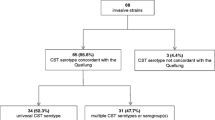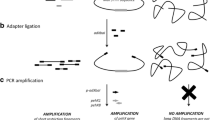Summary
During a period of 2 years, 118 strains ofEnterobacter cloacae were collected consecutively in connection with nosocomial infections in Northern Norway; identified by conventional methods and by the API 20E system. The API 20E profile 3305573 predominated and was present in 73 of 118 strains. Among 96 serotyped strains, 73 were serotypable, 20 nontypable and two polyagglutinable. Predominating serotypes were 3 (29 strains), 8 (21 strains) and 23 (nine strains). When the API 20E profiles of the 118 strains were read in the new ATB (automated computer-assisted) 20E data base system, 97 of 118 (82.2%) strains were identified asE. cloacae. The 118 strains were tested in the new ATB Rapid ID 32E and ATB ID 32E (ATB system, bioMérieux, France) systems. Only 69 of 118 (58.5%) strains were identified asE. cloacae in both systems. The ATB Rapid ID 32E identified 97 of 118 strains (82.2%), and the ATB ID 32E only 80 of 118 strains (67.8%). Among 73 serotypable strains, the ATB Rapid ID 32E identified 79.5% asE. cloacae, while the ATB ID 32E identified only 64.4%. Among 40 serotypable strains with API 20E profile 3305573, all 40 were identified asE. cloacae by the ATB Rapid ID 32E, while only 27 (67.5%) by the ATB ID 32E system. Further improvements may increase the value of biochemical identification ofE. cloacae in diagnostic work.
Zusammenfassung
Während 2 Jahren wurden 118 konsekutive Stämme vonEnterobacter cloacae, die in Nordnorwegen im Zusammenhang mit nosokomialen Infektionen isoliert wurden, gesammelt. Die Identifizierung erfolgte mit konventionellen Methoden und mit dem API 20E-System. Am häufigsten fand sich das API 20E-Profil 3305573, das bei 73 der 118 Stämme nachzuweisen war. Die Serotypisierung war bei 73/96 Stämmen möglich, 20 Stämme konnten nicht serotypisiert werden und bei zwei Stämmen trat Mehrfachagglutination ein. Die häufigsten Serotypen waren 3 (29 Stämme), 8 (21 Stämme) und 23 (neun Stämme). Bei Auswertung der API 20E-Profile der 118 Stämme mit der neuen ATB (automatischen, komputerassistierten)-Methode für das 20E system wurden 97/118 (82,2%) der Stämme alsE. cloacae identifiziert. Die 118 Stämme wurden einer Testung mit der neuen ATB ID 32E-Schnellmethode und dem ATB 32E (ATB System bioMérieux, Frankreich) unterzogen. Nur 69/118 (58,5%) der Stämme wurden mit beiden Methoden alsE. cloacae identifiziert. Die ATB ID 32E Schnellmethode identifizierte 97/118 Stämmen (82,2%) und die ATB IS 32E-Methode nur 80/118 (67,8%) der Stämme. Bei 73 serotypisierbaren Stämmen gelang die Identifizierung alsE. cloacae mit der ATB ID 32E-Schnellmethode in 79,5% der Fälle und mit ATB ID 32E in nur 64,4% der Fälle. 40 serotypisierbare Stämme, die das API 20E 3305573-Profil aufwiesen, wurden mit dem ATB ID 32E-System in allen Fällen alsE. cloacae identifiziert, mit dem ATB ID 32E-System hingegen nur 27 (67,5%). Weitere Verbesserungen dürften dazu beitragen, daß der Wert der biochemischen Identifizierung vonE. cloacae in der Diagnostik erhöht wird.
Similar content being viewed by others
References
Brenner, D. J. The genusEnterobacter. In:Starr, M P., Stolp, H., Truper, H. G., Balows, A., Schlegel, H. G. (eds.): The procaryotes. Springer-Verlag Berlin 1981, pp. 1173–1180.
Brenner, D. J., McWhorter, A. C., Kai, A., Steigerwalt, A. G., Farmer, J. J. III Enterobacter asburiae sp. nov., a new species found in clinical specimens, and reassignment ofErwinia dissolvens andErwinia nimipressuralis to the genusEnterobacter asEnterobacter dissolvens comb. nov. andEnterobacter nimipressuralis comb. nov. J. Clin. Microbiol. 23 (1986) 1114–1120.
Brenner, D. J., Richard, C., Steigerwalt, A. G., Asbury, M. A., Mandel, M. Enterobacter gergoviae sp. nov.: a new species ofEnterobacteriaceae found in clinical specimens and the environment. Int. J. Syst. Bacteriol. 30 (1980) 1–6.
Farmer, J. J. III, Davis, B. R., Hickman-Brenner, F. W., McWorther, A., Huntley-Carter, G. P., Asbury, M. A., Wathen-Grady, H. G., Elias, C., Fanning, G. R., Steigerwalt, A. G., O'Hara, C. M., Morris, G. K., Smith, P. B., Brenner, J. D. Biochemical identification of new species and biogroups ofEnterobacteriaceae isolated from clinical specimens. J. Clin. Microbiol. 21 (1985) 46–76.
Farmer, J. J. III, Kelly, M. T. Enterobacteriaceae. In:Balows, A., Hausler, W. J. Jr., Herrmann, K. L., Isenberg, H. D., Shadomy, H. J. (eds.): Manual of clinical microbiology. 5th edition. American Society for Microbiology, Washington 1991, pp. 360–383.
Garaizar, J., Kaufmann, M. E., Pitt, T. L. Comparison of ribotyping with conventional methods for the type identification ofEnterobacter cloacae. J. Clin. Microbiol. 29 (1991) 1303–1307.
Gaston, M. A. Isolation and selection of a bacteriophagetyping set forEnterobacter cloacae. J. Med. Microbiol. 24 (1987) 285–290.
Gaston, M. A., Bucher, C., Pitt, T. L. O serotyping scheme forEnterobacter cloacae. J. Clin. Microbiol. 18 (1983) 1079–1083.
Izard, D., Gavini, F., Trinel, P. A., Leclerc, H. Deoxyribonucleic acid relatedness betweenEnterobacter cloacae andEnterobacter amnigenus sp. nov. Int. J. Syst. Bacteriol. 31 (1981) 35–42.
Andersen, B. M., Sørlie, D., Hotvedt, R., Almdahl, S. M., Olafsen, K., George, R., Gilfillian, A. Multiply beta-lactam resistantEnterobacter cloacae infections linked to environmental flora in a unit for cardiothoracic and vascular surgery. Scand. J. Infect. Dis. 21 (1989) 181–191.
Andersen, B. M., Dahl, I. M. S., George, R. C., Gilfillian, A. Septicaemia caused by anEnterobacter cloacae strain varying in resistance against cephalosporins. Infection 17 (1989) 156–159.
Andersen, B. M., Almdahl, S. M., Hotvedt, R., Backer-Christensen, J., Beck Nicolayssen, R., Solem, O. I. Enterobacter cloacae infections at the University Hospital of Tromsø. tidsskr. Nr. Lægeforen. 110 (1990) 342–347.
Flynn, D. M., Weinstein, R. A., Nathan, C., Gaston, M. A., Kabins, S. A. Patients' endogenous flora as the source of „nosocomial“Enterobacter in cardiac surgery. J. Infect. Dis. 156 (1987) 363–368.
Gaston, M. A. Enterobacter: an emerging nosocomial pathogen. J. Hosp. Infect. 11 (1988) 197–208.
Olafsen, K., Hotvedt, R., Andersen, B. M., Almdahl, S. M, Sørlie, D. Nosocomial infections with resistantEnterobacter cloacae. Clinical development and treatment. Tidsskr. Nor. Lægforen. 109 (1989) 332–336.
Champs, C. de, Henquell, C., Guelon, D., Sirot, D., Gazuy, N., Sirot, J. Clinical and bacteriological study of nosocomial infections due toEnterobacter aerogenes resistant to imipenem. J. Clin. Microbiol. 31 (1993) 123–127.
Holmes, B., Gross, R. J. Coliform bacteria; various other members of theEnterobacteriaceae. In:Parker, M. T., Duerden, B. I. (eds.): Topley and Wilson's Principles of bacteriology, virology and immunity, vol. 2. Edward Arnold, London 1990, pp. 416–441.
Gaston, M. A., Crees-Morris, J. A., Pitt, T. L. Serotypes and biochemical profiles of British hospital strains ofEnterobacter cloacae in relation to site infection and antibiotic susceptibility. J. Hosp. Infect. 10 (1987) 17–27.
Kitch, T. T., Jacobs, M. R., Apfelbaum, P. C. Evaluation of RapID onE system for identification of 379 strains in the familyEnterobacteriaceae and oxidase-negative, gram-negative nonfermenters. J. Clin. Microbiol. 32 (1994) 931–934.
Willcox, W. R., Lapage, S. P., Curtis, M. A. Identification of bacteria by computer: theory and programming. J. Gen. Microbiol. 77 (1973) 317–330.
Author information
Authors and Affiliations
Rights and permissions
About this article
Cite this article
Andersen, B.M. Biochemical profiles and serotypes of nosocomialEnterobacter cloacae strains in Northern Norway: Biochemical identification problems with commercial test systems. Infection 23, 339–343 (1995). https://doi.org/10.1007/BF01713562
Received:
Revised:
Issue Date:
DOI: https://doi.org/10.1007/BF01713562




